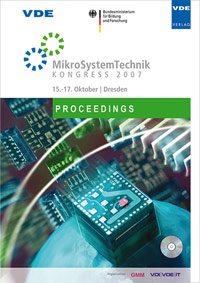High speed video analysis of μ-capsule formation for life science applications
Konferenz: MikroSystemTechnik - KONGRESS 2007
15.10.2007 - 17.10.2007 in Dresden, Germany
Tagungsband: MikroSystemTechnik
Seiten: 4Sprache: EnglischTyp: PDF
Persönliche VDE-Mitglieder erhalten auf diesen Artikel 10% Rabatt
Autoren:
Ehrhart, F.; Meiser, I.; Graf, C.; Shirley, S. G.; Zimmermann, H. (Department for cryobiophysics and cryotechnology, Fraunhofer Institute for biomedical engineering, Ensheimer Str. 48, 66386 St. Ingbert, Germany)
Müller, K.; Sukhourukov, V. L.; Zimmermann, U. (Lehrstuhl für Biotechnologie, Universität Würzburg, Biozentrum, 97074 Würzburg, Germany)
Inhalt:
Encapsulation of medically interesting cells and small tissues, producing therapeutic factors, promises to be important for the treatment of hormone deficiency diseases such as diabetes mellitus or hypoparathyroidism. The most promising material for encapsulation is alginate, a polymer from marine brown algae. Cross-linking with barium results in the formation of a hydrogel. Sophisticated extraction of alginate reduces the evoked immune response and enhances graft vitality and long-term function. Mechanical stability and diffusion parameters improve as the cross-linking becomes more homogeneous. Nevertheless, the cross-linking process itself is not fully understood and needs further investigation and new evaluation procedures. First investigations with a high speed camera showed that the cross-linking process can be divided into 4 stages: 1. deformation of the liquid alginate droplet, 2. underwater bubble, 3. erythrocyte-like stage and, finally, 4. swelling to sphere. Alginate droplets fell into different, cross-linking and non cross-linking, solutions while the impact process was recorded with a high speed camera. Afterwards, deformation of the capsule was measured. These data allow quantitative analyses of deformation during encapsulation and of the viscoelastic properties of alginate hydrogels. This new evaluation procedure gives characteristic fingerprints as the capsules horizontal diameter is plotted against time, revealing the effects of parameters like height of fall, loading with particles, alginate concentration and the composition of the cross-linking solution. We observe 3 different phases of the process: An Impact Peak, dependent on the kinetic energy of the capsule, a Recovery Peak, dependent on the cross-linking properties, and an Exponential Decay, where the capsule relaxes into spherical form. With this new technology we provide a valuable tool for detection of viscoelastic properties and polymerisation kinetics of hydrogels. Due to its simple setup and various evaluation possibilities this method is a potential routine characterisation method for clinical relevant hydrogels.


